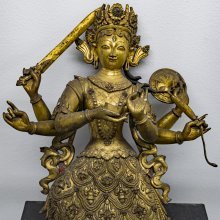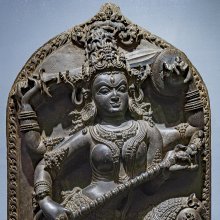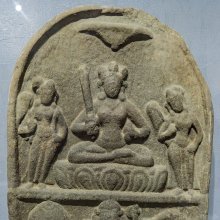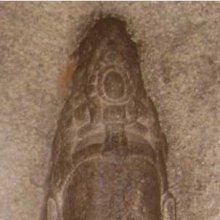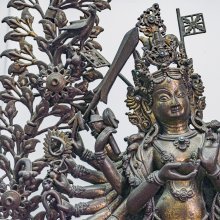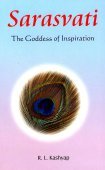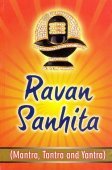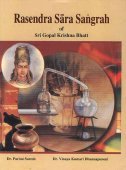Durga, Durgā, Dur-ga: 48 definitions
Introduction:
Durga means something in Hinduism, Sanskrit, Jainism, Prakrit, the history of ancient India, Marathi, Hindi, biology. If you want to know the exact meaning, history, etymology or English translation of this term then check out the descriptions on this page. Add your comment or reference to a book if you want to contribute to this summary article.
Alternative spellings of this word include Durg.
Images (photo gallery)
(+74 more images available)
In Hinduism
Purana and Itihasa (epic history)
Source: Wisdom Library: Varāha-purāṇaDurgā (दुर्गा).—Name of a river originating from Vindhya, a holy mountain (kulaparvata) in Bhārata, according to the Varāhapurāṇa chapter 85. There are settlements (janapada) where Āryas and Mlecchas dwell who drink water from these rivers.
Bhārata is a region south of Hemādri, once ruled over by Bharata (son of Ṛṣabha), whose ancestral lineage can be traced back to Svāyambhuva Manu, who was created by Brahmā, who was in turn created by Nārāyaṇa, the unknowable all-pervasive primordial being.
The Varāhapurāṇa is categorised as a Mahāpurāṇa, and was originally composed of 24,000 metrical verses, possibly originating from before the 10th century. It is composed of two parts and Sūta is the main narrator.
Source: Wisdom Library: Skanda-puranaDurga (दुर्ग, “protector”) refers to one of the fifty-six vināyakas located at Kāśī (Vārāṇasī), and forms part of a sacred pilgrimage (yātrā), described in the Kāśīkhaṇḍa (Skanda-purāṇa 4.2.57). He is also known as Durgavināyaka, Durgagaṇeśa and Durgavighneśa. These fifty-six vināyakas are positioned at the eight cardinal points in seven concentric circles (8x7). They center around a deity named Ḍhuṇḍhirāja (or Ḍhuṇḍhi-vināyaka) positioned near the Viśvanātha temple, which lies at the heart of Kāśī, near the Gaṅges. This arrangement symbolises the interconnecting relationship of the macrocosmos, the mesocosmos and the microcosmos.
Durga is positioned in the Southern corner of the first circle of the kāśī-maṇḍala. According to Rana Singh (source), his shrine is located at “South-Eastern corner of the Durga Kund, B 27 / 1”. Worshippers of Durga will benefit from his quality, which is defined as “the remover of all types of grieves”. His coordinates are: Lat. 25.17320, Lon. 82.59978 (or, 25°10'23.5"N, 82°35'59.2"E) (Google maps)
Durga, and the other vināyakas, are described in the Skandapurāṇa (the largest of the eighteen mahāpurāṇas). This book narrates the details and legends surrounding numerous holy pilgrimages (tīrtha-māhātmya) throughout India. It is composed of over 81,000 metrical verses with the core text dating from the before the 4th-century CE.
Source: Google Books: Cultural History from the Vāyu PurānaA fort or durga is perhaps surrounded by a ditch, always filled with water. There are four kinds of durgas. the first three kinds of durgas are protected by hills and ditches. The fourth kind of durga is called the Kṛtrima, i.e., artificial. It is distinguished by a rampart that runs round it. It has only one gate known as the svastika and has a Kumārīpura in it. The ditch in front of the gate is about 8 x 10 hastas deep and wide (according to some 8 x 9 hastas). River-fort (nadī-durga) is also mentioned.
Source: archive.org: Puranic Encyclopedia1) Durgā (दुर्गा).—The goddess of the universe, Durgā possesses different forms and aspects. Pārvatī, spouse of Śiva is a form of Durgā. According to the prayer of devotees this Devī assumes diverse forms. She is worshipped in 64 forms as Āryadurgā, Vedagarbhā, Ambikā, Bhadrakālī, Bhadrā, Kṣemākṣemakarī, Naikabāhu, Devī etc. In south India she is worshipped more in her fierce and terrible forms. Devī in her gentle aspects and moods assumes the forms of Kanyā, Kāmākṣī and Mūkāmbā. In Kerala the Devī is called Bhagavatī also, in Andhra Jokulāmbikā and in Tamilnadu Kaṇṇakī. Worship of the Devī is supposed to be more than 4000 years old in India. In religious literature from Vedic times up to date Devī occupies an important place. In modern India Śrī Rāmakṛṣṇa Paramahaṃsa, guru of Svāmī Vivekānanda, was a great devotee of Durgā.
In the Mahābhārata there are various references to the Devī. When the Pāṇḍavas entered the capital of Virāṭa for their life incognito they worshiped Durgā, who appeared to them and granted them certain boons. (Virāṭa Parva, Chapter 6). At the commencement of the great war Arjuna, at the instance of Kṛṣṇa prayed to Durgā, who appeared in the sky and granted him boons, for victory in War. (Bhīṣma Parva, Chapter 23). See Pañcadevīs and Prakṛti).
2) Durgā (दुर्गा).—A river famous in ancient India. The Pāṇḍavas drank water from this river. (Bhīṣma Parva. Chapter 9, Verse 33).
3) Durga (दुर्ग).—Fort. There are six kinds of forts, viz. Marudurgam, Jaladurgam, Pṛthvīdurgam Vanadurgam, Parvatadurgam, and Manuṣy adurgam. Among the above six Manuṣya durga is the most important (Mahābhārata Śānti Parva, Chapter 56, 35).
Source: archive.org: Nilamata Purana: a cultural and literary studyDurgā (दुर्गा) is the name of a Goddess that was once worshipped in ancient Kashmir (Kaśmīra) as mentioned in the Nīlamatapurāṇa.—These Goddesses (e.g., Durgā) form the shining galaxy of female deities worshipped by the people of Kaśmīra.
Source: archive.org: Shiva Purana - English Translation1) Durgā (दुर्गा) is another name for Śivā: the Goddess-counterpart of Śiva who incarnated first as Satī and then Pārvatī, according to the Śivapurāṇa 2.1.16:—“[...] the great goddess Śivā is of the three natures. Śivā became Satī and Śiva married her. At the sacrifice of her father she cast off her body which she did not take again and went back to her own region. Śivā incarnated as Pārvatī at the request of the Devas. It was after performing a severe penance that she could attain Śiva again. Śivā came to be called by various names [such as Durgā,...]. These various names confer worldly pleasures and salvation according to qualities and action. The name Pārvatī is very common.
2) Durgā (दुर्गा) is used as an epithet for Goddess Umā, according to the Śivapurāṇa 2.3.3.—Accordingly, as the Gods eulogized Umā with devotion:—“[...] O goddess Umā, mother of the universe, resident of Śivaloka, favourite of Śiva, O great goddess (i.e., Maheśvarī), O Durgā, we bow to you, With great devotion we bow to the illustrious Energy, the holy, the tranquil, the holy nourishment and the one with the forms of Mahat and the Avyakta”.
3) Durga (दुर्ग) refers to a “fort-like (city)”, according to the Śivapurāṇa 2.5.1 (“Description of Tripura—the three cities).—Accordingly, as Brahmā ordered Maya to build the three cities: “Then the intelligent Maya built the cities by means of his penance: the golden one for Tārakākṣa, the silver one for Kamalākṣa and the steel one for Vidyunmālī. The three fort-like excellent cities (durga) [trividhaṃ durgamuttamam] were in order in heaven, sky and on the earth. After building the three cities for the Asuras, Maya established them there desiring their welfare. Entering the three cities thus, the sons of Tāraka, of great strength and valour experienced all enjoyments. [...].
Source: Cologne Digital Sanskrit Dictionaries: The Purana Index1) Durga (दुर्ग).—Fortified places unknown under Pṛthu; six kinds of: Giridurga is the best; described.1 also four kinds of; three natural and one artificial; contain different outways; Kumāripuram, villages, towns surrounded by a moat, also mountains and rivers;2 desert, mountain and water; man left the tree home for this; last was artificial; made by man with ramparts, moats and Kumāripuram;3 of the southern country.4
- 1) Matsya-purāṇa 10. 32; 217. 6-87; V. I. 6. 18.
- 2) Vāyu-purāṇa 8. 98, 108 ff.
- 3) Brahmāṇḍa-purāṇa II. 7. 92, 101 ff.
- 4) Vāyu-purāṇa 45. 128.
2a) Durgā (दुर्गा).—One of the names of Yogamāya propitiated by Devakī and others for Kṛṣṇa's safe return from the cave of Jāmbavān;1 worship of;2 a Śakti;3 worshipped in the grahabali Icon of.4
- 1) Bhāgavata-purāṇa X. 2. 11; 56. 35.
- 2) Ib. XI. 27. 29.
- 3) Brahmāṇḍa-purāṇa III. 32. 24, 48 and 59; IV. 19. 81; 39. 57.; 44. 76.
- 4) Matsya-purāṇa 93. 16; 260. 55-66.
2b) A R. originating from the Vindhya Mountains.*
- * Brahmāṇḍa-purāṇa II. 16. 33; Vāyu-purāṇa 45. 103.
Durgā (दुर्गा) refers to the name of a River mentioned in the Mahābhārata (cf. VI.10.32). Note: The Mahābhārata (mentioning Durgā) is a Sanskrit epic poem consisting of 100,000 ślokas (metrical verses) and is over 2000 years old.
Source: Shodhganga: The saurapurana - a critical studyDurgā (दुर्गा) is one of the incarnations of Pārvatī, according to the 10th century Saurapurāṇa: one of the various Upapurāṇas depicting Śaivism.—Accordingly, chapter forty-eight further elaborates the glories of Śiva and Śivadharma; the results of Śiva-worship, glories of Pārvatī who is said to have been incarnated as Durgā, Satī, Kālīkā, Caṇḍi etc. for the establishment of Dharma; the extermination of the demons and the glorification of the worship of the mother-goddess including the description and praise of the Ulkānavamī-vrata are described respectively in chapters forty nine and fifty.

The Purana (पुराण, purāṇas) refers to Sanskrit literature preserving ancient India’s vast cultural history, including historical legends, religious ceremonies, various arts and sciences. The eighteen mahapuranas total over 400,000 shlokas (metrical couplets) and date to at least several centuries BCE.
Shaktism (Shakta philosophy)
Source: Wisdom Library: ŚāktismDurgā (दुर्गा, “invincible”):—Name of one of the sixty-four mātṛs to be worshipped during Āvaraṇapūjā (“Worship of the Circuit of Goddesses”, or “Durgā’s Retinue”), according to the Durgāpūjātattva. They should be worshipped with either the five upācāras or perfume and flowers.
Her mantra is as follows:
ॐ दुर्गायै नमः
oṃ durgāyai namaḥ.
A similar mantra is mentioned by the same text, prefixed with ह्रीं (hrīṃ), to be worshipped at the goddess’s right.
Source: Google Books: Manthanabhairavatantram1) Durga (दुर्ग) is the name of the Goddes in her fifth of seven births, according to the second recension of the Yogakhaṇḍa of the Manthānabhairavatantra, a vast sprawling work that belongs to a corpus of Tantric texts concerned with the worship of the goddess Kubjikā.—Accordingly, as the Lord said to Bhadrakālī: “[...] (Coming from) Himavat’s house you were married (to me) for seven rebirths. In the first (birth your) name (was) Subhagā and Kāladūtī in the second birth. You (were) Revatī in the third and Mokṣalakṣmī in the fourth. You (were) Durga in the fifth birth and Jayeśvarī in the sixth. In the previous birth—the seventh—you (were) Umā, my favourite. You became my wife on Himavat’s mountain. [...]”.
2) Durga (दुर्ग) refers to a “fort”, according to the Ṣaṭsāhasrasaṃhitā, an expansion of the Kubjikāmatatantra: the earliest popular and most authoritative Tantra of the Kubjikā cult.—Accordingly, “One should institute a great sacrifice at times of great fear, when in conflict with a powerful enemy, when the land is afflicted with drought, when locusts and soldiers come (to ravage it), when (one seeks to) remedy disease and suffering, when there is a fight between relatives for kingdom, when the king is deposed, during solitary combat in a great battle, in order to (get a) son, when one fails to gets a young virgin (bride), during a marriage, in order to gain victory, (or) when a fort is under attack [i.e., durga-abhighāta-karaṇa]. [...]”.
Source: Hare-Krsna: Nava-DurgāDurgā (दुर्गा).—According to vedic scriptures, Goddess Durgā is a symbol of power. She is worshipped in nine different forms and is therefore termed Nava-durgā. Each of the nine manifestation of Durgā is worshipped with full devotion during Navarātri.
- Śailaputrī (Daughter of the Himālayas)
- Brahmachāriṇī (One who observes the state of celibacy doing penance)
- Chandraghaṇṭā ( One who bears the moon in her necklace )
- Kūṣmāṇḍa (the creator of the universe)
- Skanda-Mātā (The mother of Skanda, Kārttikeya, born out of her powers)
- Kātyāyanī (The daughter of sage Kātyāyana, who incarnated to help the Devas)
- Kālarātrī (black as night, destroyer of Kālī)
- Mahāgaurī (the wife of Lord Shiva, doing great penance)
- Siddhidātrī (Provider of Siddhis, giver of mystic powers)
Durgā (दुर्गा) refers to one of the manifestations of Pārvatī or Śakti.—While seeing the Śakti avatāra images namely Durgā and Mahiṣāsuramardinī, who are vigorous and ferocious in their forms and character, the perceiver gets scared of the weapons held in their hands. The most scaring gestures are the tongue projecting outwards, the skull in one hand, the kapāla with blood in one hand and the wide opened eyes with full of anger. But regardless of all this the perceiver admires the force with which the goddess fights for her devotees against the enemies who harass them. While depicting her in dance, so many variations can be brought in. The goddess is said to possess ten pairs of hands and each hand holds different weapons. So in sañcāribhāvas (improvisation of a particular sentiment or a story in various ways), all these characteristics can be very well brought out.
Source: Brill: Śaivism and the Tantric Traditions (shaktism)Durgā (दुर्गा) refers to one of the nine Goddess to be worshiped as part of the Navarātra Tantric ritual (an autumnal festival of the warrior goddess Caṇḍikā).—From Pratipat to Navamī: daily worship by the king of nine maidens (kumārīpūjā) as nine goddesses, Kumārī, Trimūrti/Trimurtinī, Kalyāṇī, Rohiṇī, Kālikā, Caṇḍikā, Śāmbhavī, Durgā, Bhadrā.—Various 14th century sources refer to rituals involving the worship of Durgā, for example: Caturvargacintāmaṇi, Sāmrājyalakṣmīpīṭhikā, Puruṣārthacintāmaṇi, accounts of ceremonies in Śivagaṅgai and Ramnad, Tamil Nadu (Price 1996), Portuguese traveler accounts from the Vijayanagara Empire (Stein 1983).

Shakta (शाक्त, śākta) or Shaktism (śāktism) represents a tradition of Hinduism where the Goddess (Devi) is revered and worshipped. Shakta literature includes a range of scriptures, including various Agamas and Tantras, although its roots may be traced back to the Vedas.
Shilpashastra (iconography)
Source: Red Zambala: Hindu Icons and Symbols | DeviDurgā’s feminine power contains the combined energies of all the gods. Each of her weapons was given to her by the various gods: Rudra’s trident, Vishnu’s discus, Indra’s thunderbolt, Brahma’s Kamaṇḍalu, etc. etc. According to a narrative in the Devi Māhātmya, Durgā appeared as a warrior goddess to fight an Asura (an anti-god) named Mahiṣāsura or ‘buffalo-demon’.
Source: Shodhganga: The significance of the mūla-beras (śilpa)Durgā is the name of deity as found depicted in the Meenakshi Temple in Madurai (or Madura), which represents a sacred place for the worship of The Goddess (Devī).—(a) Durgā is represented in the standing pose called the samapāda-sthānaka with four hands. The upper two hands are in kapittha-hasta; and the lower right hand is in patāka and the lower left hand is in kuvi-patāka or slightly alapadma. While representing in iconographic form, she is represented in atibhaṅga pose with four hands. The upper two hands hold kaṭaka-hasta. The upper right hand holds the discus and the left upper hand holds the conch. The lower right hand is in abhaya and the lower left hand is in vismaya holding kapāla. Sometimes it can also be in varada holding the kapāla. (b) Durgā is represented as standing in samapāda with four hands, where the upper hands hold kartarimukha for holding the conch and discus and the lower hands in abhaya (pataka) and varada (pataka inverted).
Durgā Amman is also depicted in the Subramanya Swamy Temple (or Subramaṇya Svāmi Temple) in Thiruparankundram or Parankundram (Paraṅkuṉṟam), representing a sacred place for the worship of Murugan.—In the Durgā Amman’s sannidhi, she is represented with four hands. The upper hands carry conch and discus in the right and the left hands respectively and the lower hands are in the abhaya and varada-hastas. She is represented standing on the head of a buffalo (Mahiṣāsuramardinī). In Bharatanatyam, she is depicted with kartarīmukha-mudrā and with the lower arms with patāka and inverted patāka. Her feet are in samapāda-sthānaka. In iconographic representation, her upper arms are represented in kartarīmukha-mudrā and the lower ones in abhaya and varada-hasta.

Shilpashastra (शिल्पशास्त्र, śilpaśāstra) represents the ancient Indian science (shastra) of creative arts (shilpa) such as sculpture, iconography and painting. Closely related to Vastushastra (architecture), they often share the same literature.
Dharmashastra (religious law)
Source: Wisdom Library: Dharma-śāstraDurga (दुर्ग) refers to “fort”. It is used throughout Dharmaśāstra literature such as the Manusmṛti and the Baudhāyana-dharmasūtra.
Source: Shodhganga: Facts of society in the ManusamhitaDurga (दुर्ग):—The setting up of fort is another duty of king. While discussing on the suitable place for royal resident, the concept of fort is introduced. This is very much important for the security of not only the king himself but also the capital itself. There are six kinds of forts.
These are named thus:
- Dhānvadurga (surrounded by desert),
- Mahīdurga (built with stone or bricks),
- Abdurga (surrounded by water),
- Vārkṣadurga (surrounded by forest),
- Nṛdurga (surrounded by elephants, horses chariots and army)
- and Giridurga (on a mountain)
The king is supposed to occupy any kind of these f orts. From the security view point, these forts are very much reliable. If the king reside in any one of these forts enemy cannot assail him.
The Śāntiparva of Mahābhārata recognizes that among these six forts, Nṛdurga is the best because this type of Durga is very tough for enemies to capture.
But Kautilya recognizes only four types of durgas. These are—
- Audakdurga (water fort),
- Pārvatadurga (mountain fort),
- Dhānvadurga (desert fort)
- and Vanadurga (forest fort).

Dharmashastra (धर्मशास्त्र, dharmaśāstra) contains the instructions (shastra) regarding religious conduct of livelihood (dharma), ceremonies, jurisprudence (study of law) and more. It is categorized as smriti, an important and authoritative selection of books dealing with the Hindu lifestyle.
Arthashastra (politics and welfare)
Source: Shodhganga: Kakati Ganapatideva and his times (artha)Durga (दुर्ग).—The Nīti and Śāstra literature elaborately deals with the forts and its organisation. Nītisāra meantions four types of forts:
- sthala-durga (fort constructed on land),
- jala-durga (forts surrounded by water),
- vana-durga (forts amidst the forests),
- giri-durga (forts build on the tops of slopes of hills).
All these forts to which ever category belong must have special attālakas (rooms) over the gopuras (getes) fitted with sundry wooden contrivances (machines) guarded by warriors adepts in military exercises and the use of sundry missiles and weapons of warfare and well stocked with money and grain. They should have several extensive open grounds inside to facilitate free movement of large bodies of men and they should be provided with plentiful supplies of grain, fuel and water and have passages for the entry and the exit of the people without obstruction.

Arthashastra (अर्थशास्त्र, arthaśāstra) literature concerns itself with the teachings (shastra) of economic prosperity (artha) statecraft, politics and military tactics. The term arthashastra refers to both the name of these scientific teachings, as well as the name of a Sanskrit work included in such literature. This book was written (3rd century BCE) by by Kautilya, who flourished in the 4th century BCE.
Natyashastra (theatrics and dramaturgy)
Source: Wisdom Library: Nāṭya-śāstraDurga (दुर्ग) refers to one of the twenty prakāras: rules used in the playing of drums (puṣkara) [with reference to Mṛdaṅga, Paṇava and Dardura] according to the Nāṭyaśāstra chapter 33. Accordingly, “the playing which being irregular in its movement, develops all the mārgas and is done with undivided syllables, is called Durga”.

Natyashastra (नाट्यशास्त्र, nāṭyaśāstra) refers to both the ancient Indian tradition (shastra) of performing arts, (natya—theatrics, drama, dance, music), as well as the name of a Sanskrit work dealing with these subjects. It also teaches the rules for composing Dramatic plays (nataka), construction and performance of Theater, and Poetic works (kavya).
Kavya (poetry)
Source: Wisdom Library: KathāsaritsāgaraDurgā (दुर्गा) is one of the epithets of Durgā, according to the Kathāsaritsāgara, chapter 53. Accordingly, as Vīravara praised Durgā: “... thou art the principle of life in creatures; by thee this world moves. In the beginning of creation Śiva beheld thee self-produced, blazing and illuminating the world with brightness hard to behold, like ten million orbs of fiery suddenly produced infant suns rising at once, filling the whole horizon with the circle of thy arms, bearing a sword, a club, a bow, arrows and a spear. And thou wast praised by that god Śiva in the following words ... [Durgā, etc...]”.
Also, “... when Skanda, and Vasiṣṭha, and Brahmā, and the others heard thee praised, under these [eg., Durgā] and other titles, by Śiva well skilled in praising, they also praised thee. And by praising thee, O adorable one, immortals, Ṛṣis and men obtained, and do now obtain, boons above their desire. ”
The Kathāsaritsāgara (‘ocean of streams of story’), mentioning Durgā, is a famous Sanskrit epic story revolving around prince Naravāhanadatta and his quest to become the emperor of the vidyādharas (celestial beings). The work is said to have been an adaptation of Guṇāḍhya’s Bṛhatkathā consisting of 100,000 verses, which in turn is part of a larger work containing 700,000 verses.

Kavya (काव्य, kavya) refers to Sanskrit poetry, a popular ancient Indian tradition of literature. There have been many Sanskrit poets over the ages, hailing from ancient India and beyond. This topic includes mahakavya, or ‘epic poetry’ and natya, or ‘dramatic poetry’.
Vaishnavism (Vaishava dharma)
Source: Pure Bhakti: Bhagavad-gita (4th edition)Durgā (दुर्गा) refers to “literally, dur–‘difficult’, gā–‘to get out’, i.e. a prison. The material world is like a prison for the rebellious conditioned souls. Durgā is mother nature, the goddess of material nature and consort of Mahādeva Śiva”. (cf. Glossary page from Śrīmad-Bhagavad-Gītā).

Vaishnava (वैष्णव, vaiṣṇava) or vaishnavism (vaiṣṇavism) represents a tradition of Hinduism worshipping Vishnu as the supreme Lord. Similar to the Shaktism and Shaivism traditions, Vaishnavism also developed as an individual movement, famous for its exposition of the dashavatara (‘ten avatars of Vishnu’).
Ganitashastra (Mathematics and Algebra)
Source: archive.org: Hindu MathematicsDurgā (दुर्गा) represents the number 9 (nine) in the “word-numeral system” (bhūtasaṃkhyā), which was used in Sanskrit texts dealing with astronomy, mathematics, metrics, as well as in the dates of inscriptions and manuscripts in ancient Indian literature.—A system of expressing numbers by means of words arranged as in the place-value notation was developed and perfected in India in the early centuries of the Christian era. In this system the numerals [e.g., 9—durgā] are expressed by names of things, beings or concepts, which, naturally or in accordance with the teaching of the Śāstras, connote numbers.

Ganitashastra (शिल्पशास्त्र, gaṇitaśāstra) refers to the ancient Indian science of mathematics, algebra, number theory, arithmetic, etc. Closely allied with astronomy, both were commonly taught and studied in universities, even since the 1st millennium BCE. Ganita-shastra also includes ritualistic math-books such as the Shulba-sutras.
Jyotisha (astronomy and astrology)
Source: Wisdom Library: Brihat Samhita by VarahamihiraDurga (दुर्ग) refers to “citadels (fortified by hills or by water)”, according to the Bṛhatsaṃhitā (chapter 16) (“On the planets—graha-bhaktiyoga”), an encyclopedic Sanskrit work written by Varāhamihira mainly focusing on the science of ancient Indian astronomy astronomy (Jyotiṣa).—Accordingly, “The Moon presides over citadels fortified by hills or by water (durga), over Kosala, Bharukaccha, the sea, the city of Roma, the country of Tuṣāra, dwellers in forests, the islands of Taṅgaṇa, Hala and Strīrājya in the big seas. She presides over sweet juice, flowers, fruits, water, salt, gems, conch shells, pearls, creatures of water, paddy, barley, medicinal plants, wheat, Somayajis, kings attacked in the rear, and Brāhmaṇas. [...]”

Jyotisha (ज्योतिष, jyotiṣa or jyotish) refers to ‘astronomy’ or “Vedic astrology” and represents the fifth of the six Vedangas (additional sciences to be studied along with the Vedas). Jyotisha concerns itself with the study and prediction of the movements of celestial bodies, in order to calculate the auspicious time for rituals and ceremonies.
General definition (in Hinduism)
Source: archive.org: Vedic index of Names and SubjectsDurga (दुर्ग, ‘hard to approach’) occurs in the Rigveda as a neuter substantive only, sometimes in the sense of ‘fort’, ‘stronghold’.
Source: WikiPedia: HinduismThe Goddess who is known as the ultimate reality is the adi-parashakti, Goddess Durga . In Shaktism, She is, was and will be only owner and source of this universe and all other universes and is regarded as dynamic form of ultimate reality, Param-Brahman. Shaktas consider her dynamic Param Brahman and Param Brahman is considered as Static Adi parashakti. When there is no universe, they both unite from which universe is created and when Universe is created, Adi parashakti manifests herself as dynamic in feminine form like Goddess Parvati, Goddess Durga, Goddess Lakshmi and Goddess Saraswati. She is tridevi - the eternal beloved consort of trimurti (Godhead - the three aspects of God)
In Jainism
General definition (in Jainism)
Source: archive.org: TrisastisalakapurusacaritraDurga (दुर्ग) is the name of a Vidyādhara-city, situated on mount Vaitāḍhya (in the northern row), according to chapter 1.3 [ādīśvara-caritra] of Hemacandra’s 11th century Triṣaṣṭiśalākāpuruṣacaritra: an ancient Sanskrit epic poem narrating the history and legends of sixty-three illustrious persons in Jainism.
Accordingly,
Source: The University of Sydney: A study of the Twelve Reflections“[...] Taking their families and all their retinue and ascending the best of cars, they went to Vaitāḍhya. [...] Ten yojanas above the earth, King Vinami made at once sixty cities in a northern row at the command of the Nāga-king. [viz., Durga]. Vinami himself, who had resorted to Dharaṇendra, inhabited the city Gaganavallabha, the capital of these. [...] The two rows of Vidyādhara-cities looked very magnificent, as if the Vyantara rows above were reflected below. After making many villages [viz., Durga] and suburbs, they established communities according to the suitability of place. The communities there were called by the same name as the community from which the men had been brought and put there. [...]”.
Durga (दुर्ग) refers to a “place difficult of access”, according to the 11th century Jñānārṇava, a treatise on Jain Yoga in roughly 2200 Sanskrit verses composed by Śubhacandra.—Accordingly, “This most powerful [and] cruel death devours against their will the life of those who possess a body that has settled in the middle world, in hell, in the world of Brahmā, in Indra’s abode, in the middle of the ocean, inside the forest, at all quarters of the globe, on a mountain-peak, in a place difficult of access (durga) on account of fire, forest, cold, darkness, thunderbolts [and] swords, or in [a place] crowded with a troop of ruttish elephants”.

Jainism is an Indian religion of Dharma whose doctrine revolves around harmlessness (ahimsa) towards every living being. The two major branches (Digambara and Svetambara) of Jainism stimulate self-control (or, shramana, ‘self-reliance’) and spiritual development through a path of peace for the soul to progess to the ultimate goal.
India history and geography
Source: archive.org: Geography in Ancient Indian inscriptionsDurga (दुर्ग) is another name for the varṣaparvata (mountain range) named Himavat.—The Himavat range is said to have stretched along, on the north of Bhārata, like the string of a bow.
Source: Project Gutenberg: Castes and Tribes of Southern India, Volume 1Durga (“fort”) is one of the gotras (clans) among the Kurnis (a tribe of South India). Kurni is, according to the Census Report 1901, “a corruption of kuri (sheep) and vanni (wool), the caste having been originally weavers of wool”. The gotras (viz., Durga) are described as being of the Brāhman, Kshatriya, and Vaisya sub-divisions of the caste, and of Shanmukha’s Sudra caste.
Source: Cologne Digital Sanskrit Dictionaries: Indian Epigraphical GlossaryDurga.—(ASLV), a fort. Note: durga is defined in the “Indian epigraphical glossary” as it can be found on ancient inscriptions commonly written in Sanskrit, Prakrit or Dravidian languages.
Source: Singhi Jain Series: Ratnaprabha-suri’s Kuvalayamala-katha (history)Durgā (दुर्गा) refers to one of the deities being worshiped in ancient India, as vividly depicted in the Kathās (narrative poems) such as Uddyotanasūri in his 8th-century Kuvalayamālā (a Prakrit Campū, similar to Kāvya poetry).—The Kuvalayamala (779 A.D.) is full of cultural material which gains in value because of the firm date of its composition. [...] Page 256.31-2 ff.: Here is a mixed list of 25 gods and Godlings of all religions. These were worshipped and propitiated to obtain favours. The list includes [e.g., Durgā] [...].

The history of India traces the identification of countries, villages, towns and other regions of India, as well as mythology, zoology, royal dynasties, rulers, tribes, local festivities and traditions and regional languages. Ancient India enjoyed religious freedom and encourages the path of Dharma, a concept common to Buddhism, Hinduism, and Jainism.
Biology (plants and animals)
Source: Google Books: CRC World Dictionary (Regional names)Durga in India is the name of a plant defined with Commiphora mukul in various botanical sources. This page contains potential references in Ayurveda, modern medicine, and other folk traditions or local practices It has the synonym Commiphora mukul (Hook. ex Stocks) Engl. (among others).
Example references for further research on medicinal uses or toxicity (see latin names for full list):
· Ann. Pharmacother. (1984)
· Hooker’s Journal of Botany Kew Gard. Misc. (1849)
· Am. J. Health Syst. Pharm.
· Journal of the American Medical Association (2003)
· JAMA
· Complementary Therapies in Medicine (2005)
If you are looking for specific details regarding Durga, for example chemical composition, extract dosage, health benefits, side effects, diet and recipes, pregnancy safety, have a look at these references.

This sections includes definitions from the five kingdoms of living things: Animals, Plants, Fungi, Protists and Monera. It will include both the official binomial nomenclature (scientific names usually in Latin) as well as regional spellings and variants.
Languages of India and abroad
Marathi-English dictionary
Source: DDSA: The Molesworth Marathi and English Dictionarydurga (दुर्ग).—n m (S) A fort, fortress, strong hold.
--- OR ---
durgā (दुर्गा).—f (S) The goddess Durga, the wife of Shiva.
Source: DDSA: The Aryabhusan school dictionary, Marathi-Englishdurga (दुर्ग).—n m A fort, fortress, strong-hold.
--- OR ---
durgā (दुर्गा).—f The goddess Durga, the wife of Shiva.
Marathi is an Indo-European language having over 70 million native speakers people in (predominantly) Maharashtra India. Marathi, like many other Indo-Aryan languages, evolved from early forms of Prakrit, which itself is a subset of Sanskrit, one of the most ancient languages of the world.
Sanskrit dictionary
Source: DDSA: The practical Sanskrit-English dictionaryDurga (दुर्ग).—
1) difficult of access, inaccessible, impervious, impassable; दुर्गस्त्वेष महापन्थाः (durgastveṣa mahāpanthāḥ) Mahābhārata (Bombay) 12.3. 5; दुर्गं पथस्तत्कवयो वदन्ति (durgaṃ pathastatkavayo vadanti) Kaṭh.1.3.14.
2) unattainable.
3) incomprehensible.
4) following wicked path, vicious; Rām.2.39.22. (-gaḥ, -gam) 1 a difficult or narrow passage through a wood or over a stream, mountain &c., a defile, narrow pass.
2) a citadel. fortress, castle; न दुर्गं दुर्गमित्येव दुर्गमं मन्यते जनः । तस्य दुर्गमता सैव यत्प्रभुस्तस्य दुर्गमः (na durgaṃ durgamityeva durgamaṃ manyate janaḥ | tasya durgamatā saiva yatprabhustasya durgamaḥ) || Śiva. B.16.61.
3) rough ground.
4) difficulty, adversity, calamity, distress, danger; निस्तारयतिं दुर्गाच्च (nistārayatiṃ durgācca) Manusmṛti 3.98;11.43; मच्चित्तः सर्व- दुर्गाणि मत्प्रसादात्तरिष्यसि (maccittaḥ sarva- durgāṇi matprasādāttariṣyasi); Bhagavadgītā (Bombay) 18.58. (-gaḥ) 1 bdellium.
2) the Supreme Being.
3) Name of an Asura slain by Durgā (thus receiving her name from him). °अध्यक्षः, °पतिः, °पालः (adhyakṣaḥ, °patiḥ, °pālaḥ) the commandant or governor of a castle. °अन्तः (antaḥ) The suburb of a fort; दुर्गान्ते सिद्धतापसाः (durgānte siddhatāpasāḥ) Kau. A. 1.12. °कर्मन् (karman) n. fortification. °कारक (kāraka) a. making difficult.
-kaḥ the birch tree. °घ्नी (ghnī) Name of Durgā. °तरणी (taraṇī) an epithet of Sāvitrī. सावित्री दुर्गतरणी वीणा सप्तविधा तथा (sāvitrī durgataraṇī vīṇā saptavidhā tathā) Mb. °मार्गः (mārgaḥ) a defile, gorge. °लङ्घनम् (laṅghanam) surmounting difficulties.
-naḥ a camel. °संचरः (saṃcaraḥ)
Durga is a Sanskrit compound consisting of the terms dur and ga (ग).
Source: Cologne Digital Sanskrit Dictionaries: Edgerton Buddhist Hybrid Sanskrit DictionaryDurga (दुर्ग).—(1) nt. (Sanskrit id.), evil state; five such, perhaps = the five kaṣāya, q.v. (not durgati, of which there are only three or at most four): durgāni (so text) pañca, ṣaṣṭi mohānī, triṃśatiṃ ca malināni (…chinnā) Lalitavistara 372.5 (verse); (2) m. or nt. (loc. durge), name of a region (janapada) in the south: Gaṇḍavyūha 201.10, 25.
Source: Cologne Digital Sanskrit Dictionaries: Shabda-Sagara Sanskrit-English DictionaryDurga (दुर्ग).—mfn.
(-rgaḥ-rgā-rgaṃ) 1. Difficult of access or approach, inaccessible, impervious, impermeable. 2. Difficult of attainment, unattainable. n.
(-rgaṃ) 1. A fort, a strong hold, a Durga or hill fort. 2. A pass, a defile, a difficult or narrow passage over a stream or a mountain, through a wood, &c. m.
(-rgaḥ) The name of an Asura slain by Durga. f.
(-rgā) 1. The goddess Durga, the wife of Siva, and mother of Kartikeya, and Ganesa; also called Uma, and Parvati, &c.: as Durga, she is a goddess of terrific form, and irascible temper, and particularly worshipped at the Durga Puja, held in Bengal in the month of Aswin, or about October. 2. The indigo plant. 3. A creeping shrub, (Clitotia ternata.) 4. A singing bird, the Syama. E. dur bad, ill, with difficulty, gam to go, affix ḍa; the etymology of goddess is thus given, dur with difficulty; gam to be known; a knowledge of whom is obtained only by the severest austerities; or dur bad, gai to sing, who is especially hymned by the wicked; or durga the Asura slain by the goddess.
Source: Cologne Digital Sanskrit Dictionaries: Benfey Sanskrit-English DictionaryDurga (दुर्ग).—i. e. dus-ga, I. adj., f. gā. Almost impassable or inaccessible, [Mānavadharmaśāstra] 4, 77; 7, 70. Ii. m. The name of an Asura, [Harivaṃśa, (ed. Calc.)] 9426. Iii. f. gā, The wife of Śiva, Mahābhārata 4, 178. Iv. n. (also m., [Rāmāyaṇa] 4, 47, 3), 1. A difficult passage, [Bhāgavata-Purāṇa, (ed. Burnouf.)] 6, 6, 6. 2. Distress, [Mānavadharmaśāstra] 3, 98. 3. A strong-hold, [Mānavadharmaśāstra] 7, 29.
Source: Cologne Digital Sanskrit Dictionaries: Cappeller Sanskrit-English DictionaryDurga (दुर्ग).—[adjective] hard to go through or to, difficult of access or attainment, impassable, unaccessible. [masculine] [Name] of an Asura & [several] men; [neuter] rough ground, difficult place; mountain, hill, crag, stronghold, castle; difficulty, danger, distress; [feminine] ā [Name] of a goddess, the daughter of Himavant and wife of Śiva.
Source: Cologne Digital Sanskrit Dictionaries: Aufrecht Catalogus Catalogorum1) Durga (दुर्ग) as mentioned in Aufrecht’s Catalogus Catalogorum:—See Durgasiṃha.
2) Durga (दुर्ग):—grammarian and lexicographer. Often quoted by Kṣīrasvāmin, Sāyaṇa in Mādhavīyadhātuvṛtti, in Gaṇaratnamahodadhi, by Devarāja.
3) Durgā (दुर्गा):—See Devīmāhātmya.
Source: Cologne Digital Sanskrit Dictionaries: Monier-Williams Sanskrit-English Dictionary1) Durga (दुर्ग):—[=dur-ga] [from dur] a See durga (p. 487).
2) Durgā (दुर्गा):—[=dur-gā] [from dur] a See durgā (p. 487).
3) Durga (दुर्ग):—[from dur] b mfn. (2. dur and √gam) difficult of access or approach, impassable, unattainable, [Atharva-veda; Manu-smṛti; Mahābhārata] etc.
4) [v.s. ...] m. bdellium, [cf. Lexicographers, esp. such as amarasiṃha, halāyudha, hemacandra, etc.]
5) [v.s. ...] Name of an Asura (supposed to have been slain by the goddess Durgā, [Skanda-purāṇa]) and of sub voce men ([gana] naḍādi, [Pāṇini 4-1, 99]), [especially] of the commentator on Yāska’s Nirukta
6) [v.s. ...] also abridged for durga-gupta, durgā-dāsa etc. (See below)
7) Durgā (दुर्गा):—[from durga > dur] b f. See durgā
8) Durga (दुर्ग):—[from dur] n. (m. only, [Pañcatantra v, 76]; Bn.) a difficult or narrow passage, a place difficult of access, citadel stronghold (cf. ab-, girietc.)
9) [v.s. ...] rough ground, roughness, difficulty, danger, distress, [Ṛg-veda; Atharva-veda; Manu-smṛti; Mahābhārata etc.]
10) Durgā (दुर्गा):—[from dur] c f. (of ga q.v.) the Indigo plant or Clitoria Ternatea, [cf. Lexicographers, esp. such as amarasiṃha, halāyudha, hemacandra, etc.]
11) [v.s. ...] a singing bird (= śyāmā), [cf. Lexicographers, esp. such as amarasiṃha, halāyudha, hemacandra, etc.]
12) [v.s. ...] Name of two rivers, [Mahābhārata vi, 337]
13) [v.s. ...] ‘the inaccessible or terrific goddess’, Name of the daughter of Himavat and wife of Śiva (also called Umā, Pārvatī etc., and mother of Kārttikeya and Gaṇeśa cf. -pūjā), [Taittirīya-āraṇyaka x, 2, 3] (durgā devī), [Mahābhārata] etc.
14) [v.s. ...] of a princess, [Rājataraṅgiṇī iv, 659], and of other women.
Source: Cologne Digital Sanskrit Dictionaries: Yates Sanskrit-English DictionaryDurga (दुर्ग):—(rgaṃ) 1. n. A fort; a pass. f. Durgā; indigo plant; the Syāmā bird. a. Difficult of access.
Source: DDSA: Paia-sadda-mahannavo; a comprehensive Prakrit Hindi dictionary (S)Durga (दुर्ग) in the Sanskrit language is related to the Prakrit words: Dugga, Duggā.
[Sanskrit to German]
Sanskrit, also spelled संस्कृतम् (saṃskṛtam), is an ancient language of India commonly seen as the grandmother of the Indo-European language family (even English!). Closely allied with Prakrit and Pali, Sanskrit is more exhaustive in both grammar and terms and has the most extensive collection of literature in the world, greatly surpassing its sister-languages Greek and Latin.
Hindi dictionary
Source: DDSA: A practical Hindi-English dictionary1) Durga (दुर्ग) [Also spelled durg]:—(nm) a fort, castle; citadel; ~[pati] master of a fort, fort commander; ~[pāla] protector of the fort, fort-guard.
2) Durgā (दुर्गा):—(nf) the spouse of Shiv, symbolising primaeval energy worshipped in different forms; a heroic woman-destroyer of sinners; a shrew.
...
Kannada-English dictionary
Source: Alar: Kannada-English corpusDurga (ದುರ್ಗ):—[adjective] that is difficult to access or enter into; inaccessible.
--- OR ---
Durga (ದುರ್ಗ):—
1) [noun] the quality or condition of being inaccessible; inaccessibility.
2) [noun] a fortified place; a fort.
3) [noun] a thick forest (which is difficult to walk in).
4) [noun] a city or town.
5) [noun] a hill or mountain.
Kannada is a Dravidian language (as opposed to the Indo-European language family) mainly spoken in the southwestern region of India.
See also (Relevant definitions)
Starts with (+162): Durga jambumargashramanivasin, Durga-dandanayaka, Durga-putra, Durga-shreshthin, Durgabhaktilahari, Durgabhaktiprakasha, Durgabhaktitaramgini, Durgabhaktitarangini, Durgabhanjana, Durgacarita, Durgacarya, Durgadadinamastotra, Durgadakaradisahasranamastotra, Durgadasa, Durgadasa vacaspati, Durgadasa vidyavacaspati, Durgadatta, Durgadatta maithila, Durgadatta sanmishra, Durgadesha.
Ends with (+38): Abdurga, Abhidurga, Adurga, Baladurga, Banadurga, Bhudurga, Brahmadurga, Brihaddurga, Dantidurga, Devadurga, Dhanudurga, Dhanurdurga, Dhanvadurga, Ganeshadurga, Giridurga, Gramadurga, Hanumaddurga, Iladurga, Jaladurga, Jayadurga.
Full-text (+1821): Navadurga, Camunda, Bhadrakali, Candanayika, Giridurga, Pracanda, Daurga, Durgadhikarin, Candavati, Mahalakshmi, Mahamaya, Durgavarodha, Bhairava, Canda, Krishnapingala, Jaganmatri, Kaladamani, Gokulodbhava, Namadvadashi, Durgama.
Relevant text
Search found 134 books and stories containing Durga, Durgā, Dur-ga, Dur-gā; (plurals include: Durgas, Durgās, gas, gās). You can also click to the full overview containing English textual excerpts. Below are direct links for the most relevant articles:
Garga Samhita (English) (by Danavir Goswami)
Verse 6.19.2 < [Chapter 19 - In the First Fortress of Dvārakā, the Glories of Līlā-sarovara, etc.]
Verse 1.5.17 < [Chapter 5 - The Lord’s Appearance]
Verse 6.2.8 < [Chapter 2 - Residence in Śrī Dvārakā]
The Markandeya Purana (Study) (by Chandamita Bhattacharya)
6. Future Birth of Mahāmāyā < [Chapter 3]
Śaktism (worship of Śakti as the female goddess) < [Chapter 4]
1.10: Date of the Mārkaṇḍeya-purāṇa < [Chapter 1]
Puranic encyclopaedia (by Vettam Mani)
The Skanda Purana (by G. V. Tagare)
Chapter 47 - Installation of Goddesses at Bahūdaka Tīrtha < [Section 2 - Kaumārikā-khaṇḍa]
Chapter 72 - Victory of Durgā < [Section 2 - Uttarārdha]
Chapter 71 - Exploits of Durgā < [Section 2 - Uttarārdha]
Amarakoshodghatana of Kshirasvamin (study) (by A. Yamuna Devi)
Fauna (12): Synonyms added by Kṣīrasvāmin < [Chapter 5 - Aspects of Nature]
Tāla (beat) or Measure of time < [Chapter 4 - Cultural Aspects]
Fauna (4): Wild animals < [Chapter 5 - Aspects of Nature]
Related products
